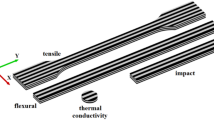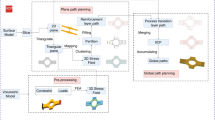Abstract
Microscopic porosity is an important cause of structural failure in 3D printing of continuous fiber reinforced polymer. To reduce the overfilling and underfilling caused during the fabrication of the molten filament under a continuous path and avoid microscopic porosity, this study proposes an adaptive co-extrusion control and optimization model to achieve uniform filling of the matrix material by dynamic adjustment. This optimization process first models the mixture ratio of the matrix material and reinforcing material using an online prepreg co-extrusion fiber filament fabrication process and then constructs a dynamic adjustment factor by analyzing the geometry of the deposition path. The dynamic extrusion volume adjustment model takes the tool path and outputs the optimized process code; therefore, it can be adapted as a post-process for similar 3D printing slicing and path planning procedures. Compared with the co-extruded model that is not optimized for matrix adaptive adjustment, the tensile and flexural strengths increased by 18% and 23.4%, respectively. The porosity decreased by 54.4%. In particular, structural failure owing to uneven filling of fiber-reinforced printed parts is avoided.
























Similar content being viewed by others
Availability of data and materials
Not applicable
References
Reece LL, Fabrizio S, Valeska PT, Tr RS (2019) Multifunctional composites: a metamaterial perspective. Multifunct Mater 2(4):043001. https://doi.org/10.1088/2399-7532/ab5242
Yaragatti N, Patnaik A (2021) A review on additive manufacturing of polymers composites. Materials Today: Proceedings 44(6):4150–4157. https://doi.org/10.1016/j.matpr.2020.10.490
Struzziero G, Barbezat M, Skordos AA (2021) Consolidation of continuous fibre reinforced composites in additive processes: a review. Additive Manufacturing 48:102458. https://doi.org/10.1016/j.addma.2021.102458
Justo J, Távara L, García-Guzmán L, París F (2018) Characterization of 3D printed long fibre reinforced composites. Composite Structures 185:537–548. https://doi.org/10.1016/j.compstruct.2017.11.052
Araya-Calvo M, Lopez Gomez I, Chamberlain-Simon NK, León-Salazar JL, Guillén-Girón T, Corrales-Cordero JS, Sánchez-Brenes O (2018) Evaluation of compressive and flexural properties of continuous fiber fabrication additive manufacturing technology. Additive Manufacturing 22:157–164. https://doi.org/10.1016/j.addma.2018.05.007
Cano-Vicent A, Tambuwala MM, Hassan SS, Barh D, Aljabali AAA, Birkett M, Arjunan A, Serrano-Aroca à (2021) Fused deposition modelling: current status, methodology, applications and future prospects. Addit Manuf 47:102378. https://doi.org/10.1016/j.addma.2021.102378
Oksman K, Skrifvars M, Selin J-F (2003) Natural fibres as reinforcement in polylactic acid (PLA) composites. Compos Sci Technol 63:1317–1324. https://doi.org/10.1016/j.addma.2021.102378
Goh GD, Dikshit V, Nagalingam AP, Goh GL, Agarwala S, Sing SL, Wei J, Yeong WY (2018) Characterization of mechanical properties and fracture mode of additively manufactured carbon fiber and glass fiber reinforced thermoplastics. Materials & Design 137:79–89. https://doi.org/10.1016/j.matdes.2017.10.021
Chen H, Wang J, Ni A, Ding A, Li S, Han X (2019) Effect of nano-OMMTs on mode I and mode II fracture toughness of continuous glass fibre reinforced polypropylene composites. Composite Structures 208:498–506. https://doi.org/10.1016/j.compstruct.2018.10.003
Nakagawa Y, Mori K-i, Maeno T (2017) 3D printing of carbon fibre-reinforced plastic parts. Int J Adv Manuf Technol 91:2811–2817. https://doi.org/10.1007/s00170-016-9891-7
Sharma P, Dhanopia AK, Joshi D (2020) An experimental study on carbon fiber thickness and layer thickness of depositing material in fused deposition modeling. Materials Today: Proceedings 44(6):4479–4484. https://doi.org/10.1016/j.matpr.2020.10.722
Wang F, Wang G-T, Ning F, Zhang Z (2020) Fiber-matrix impregnation behavior during additive manufacturing of continuous carbon fiber reinforced polylactic acid composites. Additive Manufacturing 37:101661. https://doi.org/10.1016/j.addma.2020.101661
Li H, Liu B, Ge L, Chen Y, Zheng H, Fang D (2021) Mechanical performances of continuous carbon fiber reinforced PLA composites printed in vacuum. Composites Part B: Engineering 225:109277. https://doi.org/10.1016/j.compositesb.2021.109277
Agarwal K.M, Shubham P, Bhatia D, Sharma P, Vaid H, Vajpeyi R (2022) Analyzing the impact of print parameters on dimensional variation of ABS specimens printed using fused deposition modelling (FDM). J Sens 3:100149. https://doi.org/10.1016/j.sintl.2021.100149
Parulski C, Jennotte O, Lechanteur A, Evrard B (2021) Challenges of fused deposition modeling 3d printing in pharmaceutical applications: where are we now? Adv Drug Deliv Rev 175:113810. https://doi.org/10.1016/j.addr.2021.05.020
Goh GD, Yap YL, Agarwala S, Yeong WY (2019) Recent progress in additive manufacturing of fiber reinforced polymer composite. Adv Mater Technol 4(1):1800271. https://doi.org/10.1002/admt.201800271
Yeong WY, Goh GD (2020) 3D printing of carbon fiber composite: the future of composite industry? Matter 2(6):1361–1363. https://doi.org/10.1016/j.matt.2020.05.010
Shi BH, Shang YY, Zhang P, Cuadros AP, Qu J, Sun BZ, Gu BH, Chou TW, Fu KK (2020) Dynamic capillary-driven additive manufacturing of continuous carbon fiber composite. Matter 2(6):1594–1604. https://doi.org/10.1016/j.matt.2020.04.010
Galetto M, Verna E, Genta G (2021) Effect of process parameters on parts quality and process efficiency of fused deposition modeling. Comput Ind Eng 156:107238. https://doi.org/10.1016/j.cie.2021.107238
Ćwikła G, Grabowik C, Kalinowski K, Paprocka I, Ociepka P (2017) The influence of printing parameters on selected mechanical properties of FDM/FFF 3D-printed parts. In: IOP Conference Series: Mater Sci Eng 227:012033. https://doi.org/10.1088/1757-899X/227/1/012033
Tian X, Tengfei L, Yang C, Wang Q, Li D (2016) Interface and performance of 3D printed continuous carbon fiber reinforced PLA composites. Compos Part A Appl Sci Manuf 88:198–205. https://doi.org/10.1016/j.compositesa.2016.05.032
Ueda M, Kishimoto S, Yamawaki M, Matsuzaki R, Todoroki A, Hirano Y, Duigou AL (2020) 3D compaction printing of a continuous carbon fiber reinforced thermoplastic. Compos Part A Appl Sci Manuf 137:105985. https://doi.org/10.1016/j.compositesa.2020.105985
Shuto R, Norimatsu S, Arola DD, Matsuzaki R (2022) Effect of the nozzle temperature on the microstructure and interlaminar strength in 3D printing of carbon fiber/polyphenylene sulfide composites. Composites Part C: Open Access 9:100328. https://doi.org/10.1016/j.jcomc.2022.100328
Zhao H, Chen B, Gu F, Huang QX, Garcia J, Yong C, Tu C, Benes B, Hao Z, Cohen-Or D (2016) Connected fermat spirals for layered fabrication. ACM Trans Graph 35(4):1–10. https://doi.org/10.1145/2897824.2925958
Zhang H, Yao Y, Ma Y, Lackner M, Jiang Y (2022) A 3D printing tool-path generation strategy based on the partition of principal stress field for fused filament fabrication. Int J Adv Manuf Technol 122(3–4):1719–1735. https://doi.org/10.1007/s00170-022-09957-9
Shaikh S, Kumar N, Jain PK, Tandon P (2016) Hilbert curve based toolpath for FDM process. In: CAD/CAM, Robotics and Factories of the Future: Proceedings of the 28th International Conference on CARs & FoF 2016, pp 751–759. https://doi.org/10.1007/978-81-322-2740-3_72
Huang Y, Tian X, Wu L, Zia AA, Liu T, Li D (2023) Progressive concurrent topological optimization with variable fiber orientation and content for 3D printed continuous fiber reinforced polymer composites. Composites Part B: Engineering 255:110602. https://doi.org/10.1016/j.compositesb.2023.110602
Kubalak JR, Wicks AL, Williams CB (2019) Deposition path planning for material extrusion using specified orientation fields. Proc Manuf 34:754–763. https://doi.org/10.1016/j.promfg.2019.06.209 47th SME North American Manufacturing Research Conference, NAMRC 47, Pennsylvania, USA
Zhang H, Chen J, Yang D (2021) Fibre misalignment and breakage in 3D printing of continuous carbon fibre reinforced thermoplastic composites. Addit Manuf 38:101775. https://doi.org/10.1016/j.addma.2020.101775
Hou Z, Tian X, Zhang J, Zheng Z, Zhe L, Li D, Malakhov AV, Polilov AN (2021) Optimization design and 3D printing of curvilinear fiber reinforced variable stiffness composites. Compos Sci Technol 201:108502. https://doi.org/10.1016/j.compscitech.2020.108502
Goh GD, Hamzah NMB, Yeong WY (2023) Anomaly detection in fused filament fabrication using machine learning. 3D Print Addit Manuf 10(3):428–437. https://doi.org/10.1089/3dp.2021.0231
Funding
This work is partially supported by Nano-Science and Technology Research Center at Shanghai University and the Austrian Research Promotion Agency (the Natural 3D project 860384 grant).
Author information
Authors and Affiliations
Contributions
Jinxiu Yang: designed the algorithms, experiments, and the drafted article. Yingxin Ma: provided continuous path filling method, experiments. Ling Chen: discussing, experiments designing and processing. Lijing Zhang: discussing, experiments designing and processing. Huanxiao Wu: completed part of the optimization algorithm. Yuan Yao: provided conceptualization, methodology, writing, review and editing.
Corresponding author
Ethics declarations
Ethics approval
Not applicable
Consent to participate
Not applicable
Consent for publication
Not applicable
Conflict of interest
The authors declare no competing interests.
Additional information
Publisher's Note
Springer Nature remains neutral with regard to jurisdictional claims in published maps and institutional affiliations.
Yingxin Ma, Ling Chen, Lijing Zhang, Huanxiao Wu and Yuan Yao are contributed equally to this work.
Rights and permissions
Springer Nature or its licensor (e.g. a society or other partner) holds exclusive rights to this article under a publishing agreement with the author(s) or other rightsholder(s); author self-archiving of the accepted manuscript version of this article is solely governed by the terms of such publishing agreement and applicable law.
About this article
Cite this article
Yang, J., Ma, Y., Chen, L. et al. An adaptive matrix material extrusion optimization model for in situ impregnated continuous fiber-reinforced 3D printing. Int J Adv Manuf Technol 129, 1527–1545 (2023). https://doi.org/10.1007/s00170-023-12284-2
Received:
Accepted:
Published:
Issue Date:
DOI: https://doi.org/10.1007/s00170-023-12284-2




